
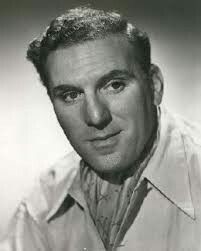 The Life of Riley (1944-45, 1945-51) aired “New Year’s Eve Party” on December 31, 1944 as the 51st of its 324 programs. The 1944-45 run (January 16, 1944 through July 8, 1945) was broadcast by the Blue Network (later to become ABC), while the show was picked up for the remainder of the 1945 season (September 8, 1945 forward) until its final show on June 29, 1951 by NBC.
The Life of Riley (1944-45, 1945-51) aired “New Year’s Eve Party” on December 31, 1944 as the 51st of its 324 programs. The 1944-45 run (January 16, 1944 through July 8, 1945) was broadcast by the Blue Network (later to become ABC), while the show was picked up for the remainder of the 1945 season (September 8, 1945 forward) until its final show on June 29, 1951 by NBC.
The show was originally pitched to the sponsor under a different title and with none other than Groucho Marx in the lead role. However, the sponsor rejected the original concept fearing the show would be just another “head-of-the-household” sitcom that wouldn’t be a good fit for Marx. Irving Brecher, the screenwriter who wrote for the Marx Brothers, undeterred, then pitched the idea with William Bendix (1906-1964) in the lead after seeing Bendix in 1942’s Hal Roach film The McGuerins from Brooklyn. With some revisions of the script originally written for Groucho and a new title, The Life of Riley was born.
The show takes place in southern California during World War II where Chester A. Riley is a working class wing riveter in the fictional Cunningham Aircraft plant. He lives in a modest suburban bungalow with his wife Peg, his son Junior, and his daughter Babs. Riley is a basically decent man, a good man with a kind heart. Aside from his family, other popular characters appearing from time to time are one of Riley’s co-workers at the aircraft plant, Jim Gillis (who inadvertantly ends up being the cause of a number of Riley’s misadventures), and Digby “Digger” O’Dell, the congenial undertaker who helps bail Riley out of holes he has dug for himself.
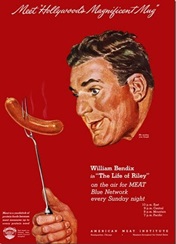
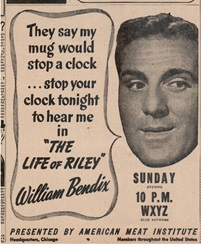 William Bendix also starred in the successful 1949 film with the same title as his popular radio show. The Life of Riley also ran on television for a single, 26-episode season from October 1949—March 1950. It ended after the 26 original episodes because Irving Brecher and the sponsor, Pabst Blue Ribbon beer couldn’t come to terms over extending the show for a full 39-week season. While at odds with Pabst Blue Ribbon as the television sponsor, the radio show was happily sponsored by The American Meat Institute (1944-45, the oldest and largest trade association representing the U.S. meat and poultry industry), Proctor & Gamble (1945-49), and the aforementioned Pabst Blue Ribbon beer (1949-51).
William Bendix also starred in the successful 1949 film with the same title as his popular radio show. The Life of Riley also ran on television for a single, 26-episode season from October 1949—March 1950. It ended after the 26 original episodes because Irving Brecher and the sponsor, Pabst Blue Ribbon beer couldn’t come to terms over extending the show for a full 39-week season. While at odds with Pabst Blue Ribbon as the television sponsor, the radio show was happily sponsored by The American Meat Institute (1944-45, the oldest and largest trade association representing the U.S. meat and poultry industry), Proctor & Gamble (1945-49), and the aforementioned Pabst Blue Ribbon beer (1949-51).
This end of the year episode has Riley revealing his good heart as he plans a small family and friends New Year’s Eve party and invites a stranger who would otherwise end up alone. With the best of intentions a misunderstanding quickly spirals into a situation with no foreseeable remedy, leaving Riley and family in an embarrassing predicament. How it works out successfully is this warm-hearted story of how people pitch in to help out their friends and neighbors, and exhibit their ingrained patriotism in the bargain. While Riley’s kind gesture gets him into trouble, the kind hearts of others get him out of it. What more could one ask of a New Year’s Eve story.
(The linked CD at top includes this episode and 15 others.)
Play Time: 29:21
{Airing late on a Sunday night didn’t deter the neighborhood gang for staying up late to listen, their parents either out at a New Year’s eve party, leaving them at home with the babysitter (which they complained they didn’t need any longer), or downstairs preparing for their own party. On Christmas and New Year’s break from school meant they could find at least one nearby newsstand that would be open for business on Monday, and is where they would gather to peruse the magazine shelves for late additions to their growing collections. Doc Savage (1933-49) had become a favorite over the years, especially now with all of his adventures fighting Japs and Nazis, doing his part to help the war effort. Doc Savage was a monthly in 1944. Jungle Stories (1938-54) had also become a favorite of the gang over the years for several obvious reasons, one of which being the Ki-Gor, Lord of the Jungle stories in each issue. While not on the level of Tarzan, Ki-Gor’s exploits entertained enough to keep readers coming back for more (along with the other obvious reason). Jungle Stories was a quarterly in 1944. The Phantom Detective (1933-53) began as a response to Street & Smith’s immensely popular pulp, The Shadow, which saw its first issue in 1931. Though The Phantom Detective’s schedule produced fewer issues per year than that of its rival and it ended with only 170 issues compared to The Shadow’s 325, it remained alive and well for a laudable 20 years, making it the longest-running single-character pulp of them all. It was a bi-monthly in 1944.}
[Left: Doc Savage, 12/44 – Center: Jungle Stories, Winter/44 – Right: The Phantom Detective, 12/44]
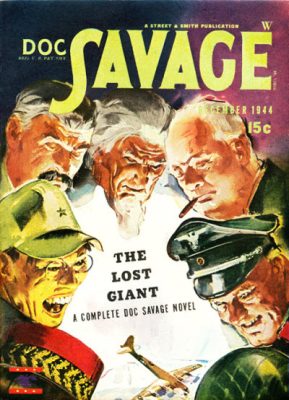
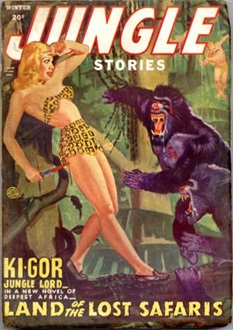
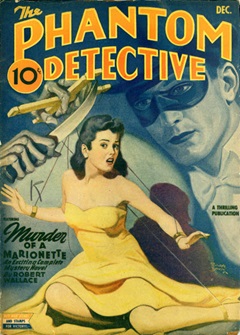
To view the entire list of weekly Old Time Radio episodes at Tangent Online, click here.